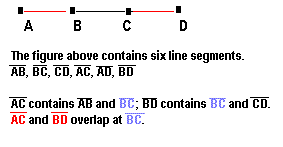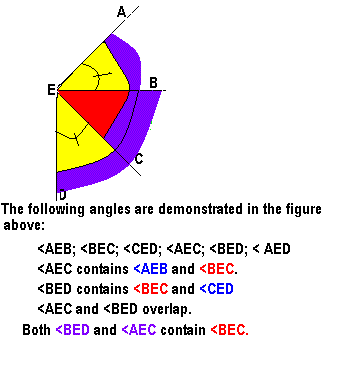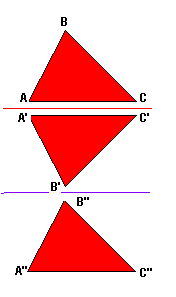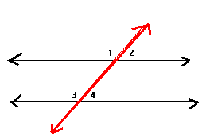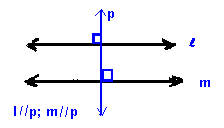In Geometry a theorem is a statement that has to be proved deductively.
Theorems are derived from postulates and conjectures.
Unit 2
Overlapping Segments Theorem:
Given a segment with points A, B, C, and D consecutively arranged so that B and C are between A and D, the following statements are true:
1. If AB = CD, then AC = BD.
2. If AC = BD, then AB = CD.
Overlapping Angles Theorem
Given <AEC with points B and C in its interior as shown, the following statements are true:
1. If m<AEB = m<CED, then m< AEC = m<BED.
2. If m<AEC = m<BED, then m<AEB = m<CED.
Vertical Angles Theorem
If two angles form a pair of vertical angles, then they are congruent.
<1 is congruent to <2
Reflection across two parallel lines is equivalent to a translation of twice the distance between the lines and in a direction perpendicular to the lines.
Reflection across two intersecting lines is equivalent to a rotation about the point of intersection through twice the measure of the angle between the lines.
Congruent Supplements Theorem: If two angles are supplements of congruent angles, then the two angles are congruent.
<DBC is congruent to <HFG
Congruent Complements Theorem:
If two angles are complements of congruent angles, then the two angles are congruent.
<BDC is congruent to <HFG
Unit 3
The properties of a parallelogram can be proven; therefore, they are theorems.
Write the converse of the following theorem.
Alternate Interior Angles Theorem: If two lines cut by a transversal are parallel, then alternate interior angels are congruent.
l ¦ m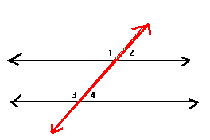
Can you list all congruent alternate interior angles and write the converse of the theorem?
Alternate exterior Angles Theorem: If two lines cut by a transversal are parallel, then alternate exterior angels are congruent.
l ¦ m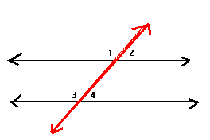
Same side Interior Angles Theorem
If two lines cut by a transversal are parallel, then same side interior angels are supplementary.
Theorem:
If two lines are parallel to the same line, then the two lines are parallel.
Given line l is parallel to line m and line n is parallel to line m. Prove line l is parallel to line n.
Triangle Sum Theorem
The sum of the measures of a triangle is 180°.
Cut the corners of the base of the triangle.
Rotate 180°. Translate the rotated figure to the apex of the triangle.
The result is a straignt angle measuring 180°
Activity: Use construction paper and show that when the corner angles of the base of a triangle are cut away, rotated and translated to the apex of the triangle, then the angles form a straight angle whose measure is 180°.
Exterior Angle Theorem
The measure of an exterior angle of a triangle is equal to the sum of the measures of the remote interior angles.
Remote interior angles are those on the leg opposite the angle adjacent to the exterior angle.
Sum of the exterior angles of a polygon.
The sum of the measures of the exterior angles of a polygon is 360°. This means if these angles were cut out and placed together, a circle could be formed.
Sum of the Interior Angles of a Polygon
The sum, s, of the measures of the interior angles of a polygon with n sides is given by the formula, s = (n-2)180.
Polygon
|
Number of sides
|
Number of triangular regions
|
Sum of interior angles
|
Triangle
|
3
|
1
|
180
|
Quadrilateral
|
4
|
2
|
360
|
Pentagon
|
5
|
3
|
540
|
Hexagon
|
6
|
4
|
720
|
Heptagon
|
7
|
5
|
900
|
Octagon
|
8
|
6
|
 |
Nonagon
|
9
|
7
|
1260
|
Decagon
|
 |
8
|
 |
Dodecagon
|
12
|
10
|
1800
|
n-gon
|
 |
(n-2)
|
 |
Fill in the missing data.
|
AAS (Angle-Angle-Side) Congruence Theorem
If two angles and a nonincluded side of one triangle are congruent to the corresponding angles and nonincluded side of another triangle, then the triangles are congruent.
HL (Hypotenuse-Leg) Congruence Theorem
If the hypotenuse and a leg of a right triangle are congruent to the hypotenuse and a leg of another right triangle, then the two right triangles are congruent.
Isosceles Triangle Theorem
If two sides of a triangle are congruent, then the angles opposite those sides are congruent.
Converse of the Isosceles Triangle Theorem.
If two angles of a triangle are congruent, then the sides opposite those angles are congruent.
Equilateral triangle Corollary.
The measures of each angle of an equilateral triangle is 60 degrees.
Vertex Angle Bisector Corollary.
The bisector of the vertex angle of an isosceles triangle is the perpendicular bisector of the base.
 Theorems
Theorems
 A diagonal of a parallelogram divides the parallelogram into two congruent triangles.
A diagonal of a parallelogram divides the parallelogram into two congruent triangles. Opposite sides of a parallelogram are congruent.
Opposite sides of a parallelogram are congruent. Opposite angles of a parallelogram are congruent.
Opposite angles of a parallelogram are congruent. Consecutive angles of a parallelogram are supplementary.
Consecutive angles of a parallelogram are supplementary. The diagonals of a parallelogram bisect each other.
The diagonals of a parallelogram bisect each other. A rhombus is a parallelogram.
A rhombus is a parallelogram. A rectangle is a parallelogram.
A rectangle is a parallelogram. The diagonals of a rhombus are perpendicular (they measure 90 degrees).
The diagonals of a rhombus are perpendicular (they measure 90 degrees). The diagonals of a rectangle are congruent.
The diagonals of a rectangle are congruent. The diagonals of a kite are perpendicular.
The diagonals of a kite are perpendicular. A square is a rectangle.
A square is a rectangle. A square is a rhombus.
A square is a rhombus. The diagonals of a square are congruent and are the perpendicular bisectors of each other.
The diagonals of a square are congruent and are the perpendicular bisectors of each other.
Theorems of quadrilaterals that are parallelograms.
 If two pairs of opposite sides of a quadrilateral are congruent, then the quadrilateral is a parallelogram.
If two pairs of opposite sides of a quadrilateral are congruent, then the quadrilateral is a parallelogram. If one pair of opposite sides of a quadrilateral are parallel and congruent, then the quadrilateral is a parallelogram.
If one pair of opposite sides of a quadrilateral are parallel and congruent, then the quadrilateral is a parallelogram. If the diagonals of a quadrilateral bisect each other, then the quadrilateral is a parallelogram.
If the diagonals of a quadrilateral bisect each other, then the quadrilateral is a parallelogram.
Theorems of parallelograms that are rectangles or rhombuses.
 If one angle of a parallelogram is a right angle, then the parallelogram is a rectangle.
If one angle of a parallelogram is a right angle, then the parallelogram is a rectangle. If the diagonals of a parallelogram are congruent, then the parallelogram is a rectangle (This is known as the "House builder's Theorem".)
If the diagonals of a parallelogram are congruent, then the parallelogram is a rectangle (This is known as the "House builder's Theorem".) If one pair of adjacent sides of a parallelogram are congruent, then the parallelogram is a rhombus.
If one pair of adjacent sides of a parallelogram are congruent, then the parallelogram is a rhombus. If The diagonals of a parallelogram bisect the angles of the parallelogram, then the parallelogram is a rhombus.
If The diagonals of a parallelogram bisect the angles of the parallelogram, then the parallelogram is a rhombus. If the diagonals of a parallelogram are perpendicular, then the parallelogram is a rhombus.
If the diagonals of a parallelogram are perpendicular, then the parallelogram is a rhombus.
 The triangle midsegment theorem:
The triangle midsegment theorem:A midsegment of a triangle is parallel to a side of the triangle and has a measure equal to half of the measure of that side.
 The center of the circumscribed circle for a right triangle is the midpoint of the hypotenuse
The center of the circumscribed circle for a right triangle is the midpoint of the hypotenuse The midpoints of a quadrilateral are the vertices of the parallelogram.
The midpoints of a quadrilateral are the vertices of the parallelogram.
 Definition of distance.
Definition of distance.
 Theorem: Sets of Parallel lines
Theorem: Sets of Parallel linesIn a perspective drawing, all lines that are parallel to each other, but not to the picture plane, meet at a single point known as the vanishing point.
 Theorem: Lines Parallel to the Ground
Theorem: Lines Parallel to the GroundIn a perspective drawing, a line that is in the plane of the ground in the drawing and is not parallel to the picture plane will meet the horizon of the drawing at the same point.
